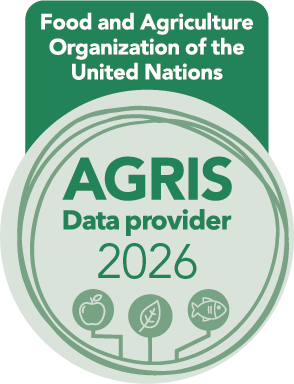Effect of Different Doses of QuitoMax on the Growth of Cucumber (Cucumis sativus L.) Seedlings
DOI:
https://doi.org/10.5281/zenodo.10231180Keywords:
Cucumis sativus, growth regulators, germinationAbstract
The experiment was carried out in the laboratory at the Faculty of Agricultural Sciences, University of Granma. The aim of the experiment was to evaluate the effect of QuitoMax on seed germination and the growth of cucumber seedlings. Four experimental variants were evaluated: 1.5, 1, 0.5, and 0.25 concentrations, in which the seeds were imbibed for 4 hours. The dynamics of germination, height, and fresh mass of the seedlings were evaluated 15 days after. The results showed the effect of QuitoMax on germination dynamics. The seeds in the 1.5 concentration underwent the shortest germination time, and showed the best effect on plant height. The fresh mass increased in the 1.5 concentration.
Downloads
References
El Hadrami, A., & Adam L. R., El Hadrami, I. & Daayf, F. (2010). Chitosan in Plant Protection. Marine Drugs, 8(4), 968-987, doi: doi.org/10.3390/md8040968
Falcón Rodríguez, A. B., Costales Menéndez, D., González-Peña Fundora, D., & Nápoles García, M. C. (2015). Nuevos productos naturales para la agricultura: las oligosacarinas. Revista Cultivos Tropicales, 36 (Supl. 1). Retrieved from: http://scielo.sld.cu/scielo.php?script=sci_arttext&pid=S0258-59362015000500010
González Gómez, L. G., Jiménez Arteaga, M. C., Terrero Soler, J., Araujo Aguilera, L., Paz Martínez, I., Arias, R. I., & Falcón Rodríguez, A. (2016). Resultados obtenidos con la aplicación de Quitomax (Quitosana) en el cultivo de tabaco (Nicotiana tabacum L.): en la Provincia Granma. La Habana: Editorial Universitaria. Universidad de Granma. Retrieved from: http://beduniv.reduniv.edu.cu/fetch.php?data=107&type=pdf&id=2722&db=0
Jerez Mompie, E., Martín Martín, R., Morales Guevara, D., & Reynaldo Escobar, I. (2017). Efecto de oligosacarinas en el comportamiento de la papa (Solanum tuberosum L.) variedad Romano. Cultivos Tropicales, 38 (1), 68-74. Retrieved from: http://scielo.sld.cu/pdf/ctr/v38n1/ctr08117.pdf
Karlova, R., & de Vries, S. C. (2006). Advances in Understanding Brassinosteroid Signaling. Science Signaling Sci. STKE, 2006 (354), pe36, doi: http://stke.sciencemag.org/content/2006/354/pe36
Kiirika, L. M., Stahl, F. & Wydra, K. (2013). Phenotypic and molecular characterization of resistance induction by single and combined application of chitosan and silicon in tomato against Ralstonia solanacearum. Physiological and Molecular Plant Pathology, 81, 1-12, doi: https://doi.org/10.1016/j.pmpp.2012.11.002
Muzzarelli, R. A.A., Boudrant, J., Meyer, D., Manno, N., DeMarchis, M., & Paoletti, M. G. (2012). Current views on fungal chitin/chitosan, human chitinases, food preservation, glucans, pectins and inulin: A tribute to Henri Braconnot, precursor of the carbohydrate polymers science, on the chitin bicentennial. Carbohydrate Polymers, 87(2), 995-1012, doi: https://doi.org/10.1016/j.carbpol.2011.09.063
Pérez Mesa, S., Rodríguez Pedroso, A. T., & Ramírez Arrebato, M. (octubre-diciembre, 2015). Efecto de diferentes concentraciones de quitosana sobre la germinación y crecimiento de plántulas de arroz (Oryza sativa, L.). Revista científica AVANCES, 17(4): 380-386. Retrieved from: http://www.ciget.pinar.cu/ojs/index.php/publicaciones/article/view/136/433
Rodríguez, F. P., & Castillo, C. J. (abril-junio, 2010). Producción local de pepino hibrido SARIG 454 y su impacto sobre el crecimiento y productividad del cultivo en dependencia de la biofertilizaciòn foliar en un agroecosistema santiaguero. Ciencia en su PC, (2), 114-124. Retrieved from: http://www.redalyc.org/pdf/1813/181317869010.pdf
Rodríguez Pedroso, A. T., Ramírez Arrebato, M. A., Rivero González, D., Bosquez Molina, E., Barrea Necha, L. L., & Bautista Baños, S. (2009). Propiedades químicos-estructurales y actividad biológica de la quitosana en microorganismos fitopatógenos. Revista Shapingo Serie Horticultura. 15(3): 307-317.
Rodríguez, C., & Araujo, L. A. (2013). Introducción de los resultados de la aplicación de quitosana en el cultivo del tabaco, variedad Corojo-2006. (Trabajo de Diploma). Facultad de Ciencias Agrícolas. Universidad de Granma. Granma, Cuba.
Sharathchandra, R. G., Niranjan Raj. S., Shetty. N. P., Amruthesh, K. N., & Shekar Shetty, H. (2004). A Chitosan formulation ElexaTM induces downymildew disease resistance and growth promotion in pearl millet. Crop Protection, 23(10), 881–888, doi: 10.1016/j.cropro.2003.12.008
Terry Alfonso, E., Falcón Rodríguez, A., Ruiz Padrón, J., Carrillo Sosa, Y., & Morales Morales, H. (2017). Respuesta agronómica del cultivo del tomate al bioproducto QuitoMax. Revista Cultivos Tropicales, 38(1). Retrieved from: http://scielo.sld.cu/scielo.php?pid=S0258-59362017000100019&script=sci_arttext&tlng=pt
Torres Rodríguez, J. A., Reyes Pérez, J. J., González Gómez, L. G., Jiménez Pizarro, M., Boicet Fabre, T., Enríquez Acosta, E. A., … González Rodríguez, J. C. (2018). Respuesta agronómica de dos variedades de maíz blanco (Zeas mays, L.) a la aplicación de QuitoMax, AZOFERT Y ECOMIC. Revista Biotecnia, 20(1), 3-7. Retrieved from: https://biotecnia.unison.mx/index.php/biotecnia/article/view/522/241
Downloads
Published
Issue
Section
License
Copyright (c) 2023 Yarisbel Gómez Masjuan, Norge Tornés Olivera, Gustavo González Gómez, Sánchez Reidel Oduardo

This work is licensed under a Creative Commons Attribution-NonCommercial-NoDerivatives 4.0 International License.
You are free to:
- Share — copy and redistribute the material in any medium or format
- The licensor cannot revoke these freedoms as long as you follow the license terms.
Under the following terms:
- Attribution — You must give appropriate credit , provide a link to the license, and indicate if changes were made . You may do so in any reasonable manner, but not in any way that suggests the licensor endorses you or your use.
- NonCommercial — You may not use the material for commercial purposes .
- NoDerivatives — If you remix, transform, or build upon the material, you may not distribute the modified material.
- No additional restrictions — You may not apply legal terms or technological measures that legally restrict others from doing anything the license permits.






